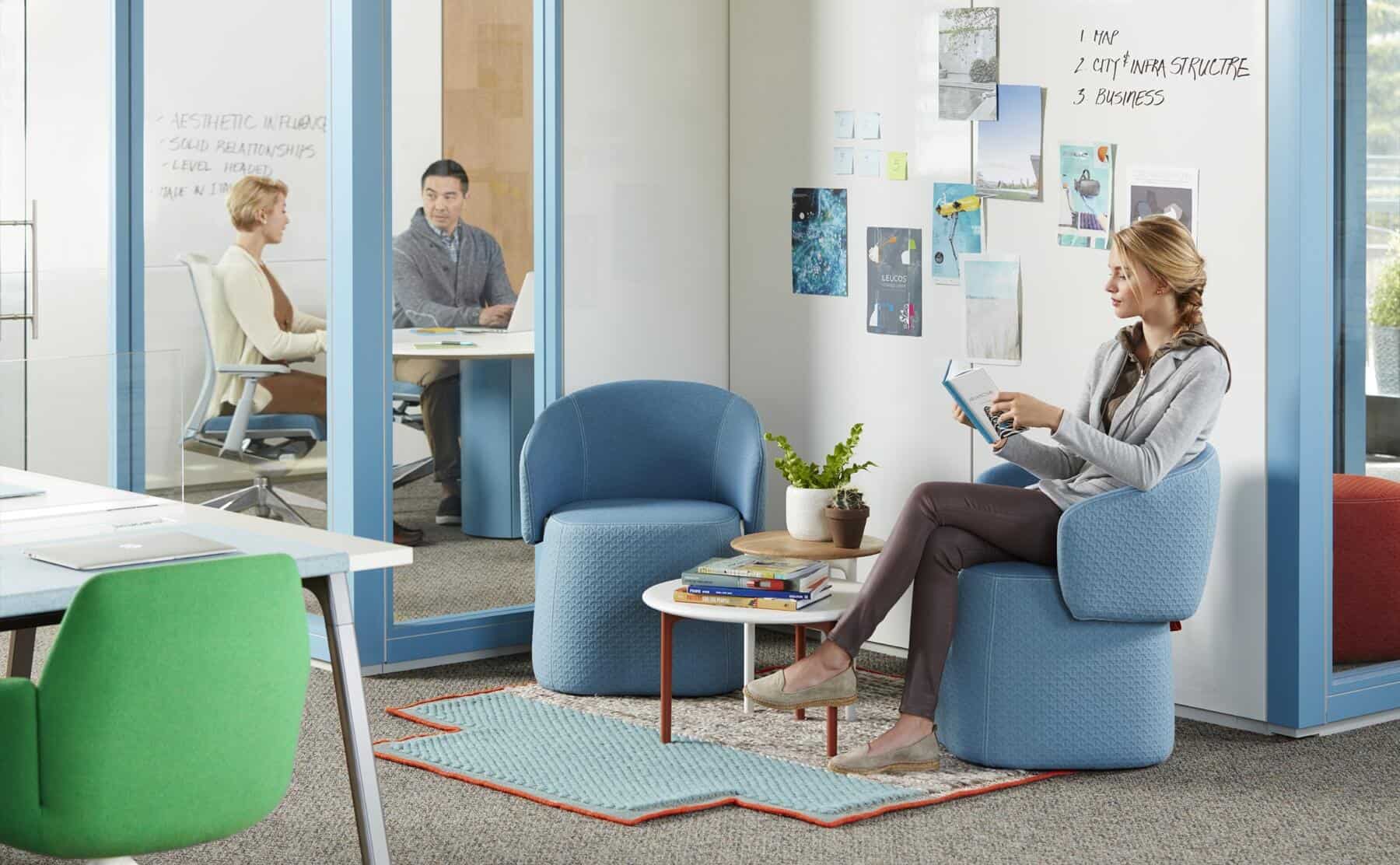
One in a Million: Individual Work and Space
One in a Million: Individual Work and Space
This paper theorizes on the relationships that exist between individuals, how they do things in the office, and how to best plan environments for those consistently displayed behaviors. Insights are offered on the differences that profession, personality, and past experience have in determining what constitutes adequate environmental support. Also included are suggestions on group implications (teaming) for various individual work-styles. Not all “teams” are alike!
Imagine
If asked to close your eyes and imagine a peaceful place where you can concentrate your thoughts and possibly solve a problem, no doubt the last place you’ll think of is your office at work. It’s doubtful that you thought of a crowded room filled with strangers or of awkward, institutional furniture akin to what you last used when you took your “driver’s test” at the local Department of Motor Vehicles.
Working space as an entity is rarely thought of as having even remote connotations of pleasantness, comfort, or desirability. Working space does, however, have quite a “touch” on individual and group productivity, individual well-being, communication of organizational values and norms, as well as having a direct impact on the organizational commitment that employees display.
It is plausible that the Department of Motor Vehicles, as mentioned earlier, has an impressive efficiency record. As an environment, it is planned for the efficient processing of people and information. The color, furnishings, lighting, and air quality all lend themselves to a model of “transaction with ruthless efficiency”. Get in, get it done, and get out. It’s a cost effective space that could well be the ideal facilities model for an organization.
On the other hand, let’s consider the other end of the state — the office of the Governor; plush velvet drapes, hand carved walnut desks with considerable ornamentation, walls covered with icons of stability, effectiveness, commitment, prosperity, and hope. I have yet to see a fluorescent ceiling fixture in any gubernatorial chamber. These spaces lend themselves not to ruthless efficiency but to strategic intent. Calm, introspective arenas in which people connect and the influence of ideals is central. These two environmental extremes illustrate how social relations and physical conditions impact behavior, performance, and expectations. Physical conditions of work and the impressions they form within us remain a hidden dimension within organizations in spite of studies that have demonstrated the relationship between the adequacy of objective environmental conditions (such as air quality, lighting, furnishings, and access to natural views) and job satisfaction.
Job Satisfaction and the Environment
Keep in mind that the individual components of job satisfaction (in reality, the majority of topics) reach far beyond the physical environmental into areas of organizational management, individual motivation, individual health, meaningfulness of work, compensation, and a host of issues that lie beyond the sphere of influence of most Corporate Real Estate (CRE) groups.
A prime focus in the arena of satisfaction will center primarily on person environment studies. Within this discipline it has been demonstrated that occupants assess the physical environment based on that settings adequacy for the task at hand, arrangement, symbolic features, and the amount of control over the design and use of that space. These are the central elements that impress an occupants overall “sense of place”. While this impact has been viewed as large as 10% and as little as 4% in overall “value”, it constitutes a value which is variable and able to be manipulated for the well-being of a population. As for the low percentage, remember that the bit in a racehorse’s mouth, while representing a small percent of the racehorse, affects a large degree of where that racehorse goes and just how quickly.
Individual work style is influenced by many factors such as personality, situation, social context, pressure, environment, and personal expectation.
These key environmental features can (and will) be interpreted by individuals in a myriad of ways and will manifest themselves in individual perceptions of conditions that include the adequacy of lighting, temperature, and humidity preferences to crowding, density, and a sense of physical security. Interpretation of these conditions will drive people to seek an optimal, individually determined level of comfort and social interaction, which will be accomplished primarily through adjustment of the physical environment. Failure of the environment to support this need for individual adjustment begins a downward spiral that may begin with lowered environmental satisfaction. Lowered environmental satisfaction has been linked to decreased productivity and lower job satisfaction which has in turn been linked to reduced organizational commitment.
The Price of Success
Planning modes that stress primarily facilities efficiency through efforts to contain costs through reduction of gross square footage per person, introduction of homogenized work environments for the sake of simplification and the sacrifice of individuality for the benefit of utility, are essentially programs that are high risk, short-term “firecrackers” that increase the likelihood of environmental dissatisfaction. Having outlined the results of dissatisfaction, I propose we dwell on the possibilities of satisfaction.
Our earlier discussion of person-environment fit highlights that congruence in this realm is a significant predictor of job satisfaction. Ensuring that adequacy, arrangement, symbolic feature, and control are best supported for the individual becomes a central theme in the design program phase of project planning. Central to that task is an understanding of the nature of work and human interaction. HR professionals are keen in this effort of linking personal ability and potential to specific job requirements.
When hiring staff, it is essential to know if the task to be performed is strategic or tactical in nature. Simply put, you’re either planning or doing and strategic ability along with tactical effectiveness rarely resides in one person. If we take this dual model and further refine it, we can see a framework being established for a “taxonomy” of styles of work that are a clustering of individual work behaviors. These individual work behaviors are influenced in large by specific personality traits, by situation, by experience, and by individual expectations. One key assumption here is that personality traits are stable over time. Behaviors may change per situation but personality in adults, largely, remains constant.
A second key assumption is that personality influences vocational interests. With these conditions as a social framework, we can begin to place individual task behaviors into four separate quadrants that display a “competing values” relationship. This relationship has significant physical environmental implications for both individuals and their larger related work groups. These environmental implications frequently are ignored, misapplied, misunderstood, or are erroneously used as a fulcrum to “change” personality/behavior in the belief that a larger, organizational “cultural shift” will ensue.
By understanding these individual nuances in problem approach and resolution — and by instituting a methodology aimed at identifying issues and aiding on behalf of the occupant in the articulation of what constitutes meaningful dimensions of environmental preference — it may be possible through design to lessen the chasm between building centric and human centric design logic.
A model of Work Behaviors
It is proposed here that a model exists in which specific, preferred ways of working can be identified and that behavioral traits related to individual personality are key determinants of those preferences.
To understand the model, we must first understand this behavioral clustering of which there are four distinct categories:
• Transactional
Characterized by work that may be lower in autonomy and lower in interaction, transactional work is typically high in task focus and requires a worker to spend a large amount of time in his or her primary workspace (high occupancy). The work may be characterized as being “systemized and routine” with strict adherence to standards being the norm. The social implications arise in the fact that visual connectivity to peers is important for social value as much as for active problem solving. There is typically a low expectation for privacy.
• Concentrative – Technical
Concentrative – Technical workers typically are involved in work that is high in autonomy and lower in interaction, hence the amount of visual and acoustic separation is increased. These workers typically find their assignments to be challenging, requiring action and results orientation. Efficient methodologies are employed in the studying and solving of problems. A high degree of concentration is required and visual connectivity to peers becomes less important for individual work output. Extroverted individuals find these environments “stifling”.
• Concentrative – Collaborative
Concentrative – Collaborative workers are typically involved in work that is high in autonomy and high in interaction, hence the amount of privacy (the interaction barriers) is reduced. Efforts are more people focused than task focused and persuasive communication, testing of new ideas, and immediacy of action become central to work process. Introverts are typically quite uncomfortable in these environments.
• Consultative
Space implications for Consultative workers reflect the need for work to be done distraction free for significant periods of time. Typically this group deals with strategic thought and high degrees of confidentiality. The very nature of the work is based on the effective handling of organizational and competitive intelligence as well as internally focused personnel issues. Coaching and counseling are key functions as “solutions to people problems” usually reside here. Optimistic outlook, mobility and the ability to verbalize thoughts and ideas effectively are prime functional requirements of these individuals. This group of workers generally has the lowest occupancy rates for a given space.
The conundrum that ensues from the contrast of work style and organizational need (I need privacy with total accessibility) is one that is common in North America.
Within this model of work behaviors there exists the ability to blend primary and secondary work style characteristics to better accommodate individual occupant preference. For example, an engineering project manager may well follow the characteristics of Concentrative – Technical and Consultative workstyles. The work function requires a mid level degree of skills with people, a high degree of skills with data such as analysis and synthesis, and a lower level of skill with the manipulation of things (it’s helpful if the PM can set up a brake press and do steel layout, but not essential to the function).
This blending of primary and secondary characteristics allows for a finer interpretation of work behaviors and suggests that the immediate environment supporting those tasks be outfitted to better accommodate requisite levels of concentration and interaction. In the case of our imaginary engineering project manager, our reflected environment will need to support not only distraction free work, but will need immediate interaction space. The conundrum that ensues from the contrast of work style and organizational need (I need privacy with total accessibility) is one that is common in North America. The answer lies within the organizational culture implications that parallel this study.
Workgroup Implications
Along with these four individual work taxonomies come workgroup implications. Four workgroup types that have been previously identified are: Advice/Involvement, Project/Development, Production/Service, and Action/Negotiation.
Work at the level of the individual has a root value that is critical to future group effort, and space that adequately supports individual effort is essential. A macro-level organizational trend that has been occurring over the last 30 years includes the shift from “departmental silos” to integrated solutions. A similar trend in the changing nature of work is the shift from independent to collaborative effort. Organizational synergy such as the sharing of information and skills across work and organizational types is vital to effective utilization of corporate intelligence.
These macro-trends have forged environmental conditions which have forced workers, previously unfamiliar with group process, to become part of a “larger solution”. Still, those independent work types harbor a degree of commonality in work output and the group process designed to support such reflect a consistent pattern. Those patterns are identified as follows.
Within the Transactional model, the typical work team composition (work team is defined as small groups of interdependent individuals who share responsibilities for outcomes of their organizations) can be described as Advice/Involvement. These groups are typically committees, review boards, quality control circles, employee involvement groups, and advisory councils. The output from these groups is usually in the form of decisions, selections, suggestions, proposals, or recommendations.
Physical proximity and group territory and boundary markers are important for identity purposes only and variation in environment is not important. Technologic connectivity is low as is the need for dedicated space. Work team differentiation is low – that is its membership is composed of individual members and there is often a short group life and a limit to the amount of working time.
The Concentrative – Technical group is characterized as a Project/Development group. This is typically a research group, planning team, architect or engineering team, a development team or task force. Physical boundary and proximity of individual members is of critical importance. Variation in environment is important (meaning a variety of environments are available to the members) as is technological connectivity. Time involved on task is substantial and, as such, there is a strong need for dedicated space.
Members are usually expert specialists and may have an extended team lifespan. Work cycles typically differ for each project and one project may represent the team lifespan. The output from this type of group may be plans, designs, presentations, prototypes, reports, and findings.
The Concentrative – Collaborative group environment can be described as a Production/Service offering. Physical proximity and group territory may be of greater importance as the need for immediacy precipitates the actions of the members. Interaction is essential in information gathering and dissemination, so proximity gets high marks for importance. These groups may have variable membership requirements and are occasionally marked by high turnover. There is a variable team lifespan and work cycles are typically repeated or a continuous process. Typical outputs of these groups may be in the form of food, chemicals, components, assemblies, retail sales, and customer service.
The last group, Consultative, is considered as an Action/Negotiation team. These are characterized as negotiation teams, surgery teams, expeditions, contract, or lawsuit teams. Physical proximity and group boundaries/territories are important in their symbolic value, but not in tactical value.
Organizational Culture Implications
These individual and group taxonomies have specific spatial requirements and expectations in the form of work surface amount, amount of enclosure, storage for individual and group, square footage of floor space, technology integration, and individual space occupancy patterns. It is interesting to note that when an individual’s work style evaluation is placed in an Organizational Culture context, the result is an individual expectation of environmental preference that is moderated by the cultural implications.
In a competing values framework of organizational culture such as identified by Kim Cameron and Robert Quinn in their 1999 Diagnosing and Changing Organizational Culture publication, it becomes apparent that overlaying cultural taxonomy over work style taxonomy results in a finer description of spatial expectation. Recalling the implications of individual personality in profession and problem resolution paths, it is now possible to add the implication of organizational personality to this mix.
Cameron and Quinn identify four distinct organizational types: Control (hierarchy), Collaborate (clan), Create (adhocracy), and Compete (market). Each of these social constructs has group level relevance, which helps explain why differing industries at different levels of maturity use similar, consistent human skill sets and obtain markedly differing results. The organizational construct is, in essence, the context of behavioral condition. One acts very different in a conservative social setting than in a relaxed or casual social setting. Ever wear tennis shoes and jeans to a formal dinner? To continue illustrating this theory, let’s revisit the earlier mentioned mythical engineering manager. If the cultural context of that manager fits within a more “adhocratic” description, the likelihood of being assimilated into a culture of entrepreneurial spirit is greater. The likelihood of distractions being tolerated and design solutions being more inclusive of “immediacy of interaction” type space is increased. If, however, the organization follows a more traditional path such as the “hierarchical” description; then the chances of interruptions being viewed as “intolerable” will increase. Collaborative space may ultimately be positioned farther away from the immediate locus of individual work.
Orgazational Soothsavig?
How does one begin to identify and prioritize these conditions in an attempt to align organizational goals and conditions with individual needs? Is it even possible to diagnose and resolve individual and group level environmental issues with seemingly simple, heuristic recipes? Is it even advisable?
As mentioned at the onset of this paper, organizational development is a complex process and environment represents (academically) a largely untested field of theory, tale, trial and error with no central repository for lessons learned. Combine this with that hopeless variable of the insanely adaptive, yet predictably inflexible cat known as “human” and you have a stage set in which we can define what we don’t know better than what we do know. Given these complexities and the desire to constrain capital costs within an organization, the remaining challenge for the design profession becomes one of optimization of space.
The design profession at large has given us much in terms of constructive, effective, intuitively derived solutions in this arena and have demonstrated an understanding of the impact environment can have on individual behavior. If we take and build upon that body of experience, our goal of effectively identifying and managing key cultural and individual orientations (behaviors) becomes a task that is more accurately aligned with the optimization of space. This effort is a critical step in fostering job satisfaction. This attempt to align singular needs of individuals with the convergent needs of many is but an initial step in the process of optimizing workspace. The thought of being “one in a million” is neither appealing nor complimentary to individuals. Better insight into the uneasily articulated conditions and expectations of those workers can lead to optimized workspace for them, helping to possibly remediate the negative effects of space that may have been previously allocated with goals other than these in mind.
by David Fik, Haworth Workstyles White Paper – Organizational Culture


